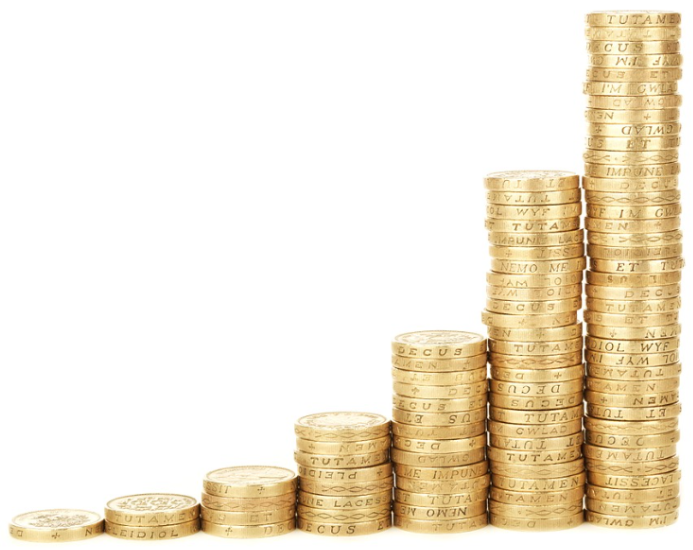Deriving the "Pert" formula.
This post is part of the series Connecting Calculus to the Real World.
Want to get notified about new posts? Join the mailing list and follow on X/Twitter.

Suppose you invest a principal amount of money, $P,$ into an account with interest rate $r$ that is compounded $n$ times per year. After $t$ years, there would be nt total compoundings, each by a factor $1+(r/n),$ so your principal amount grows to an amount
$\begin{align*} A = P \left( 1 + \frac{r}{n} \right)^{nt}. \end{align*}$
Annual compounding means $n=1.$ Monthly compounding means $n=12.$ Daily compounding means $n=365.$ If you compound every minute, then $n=(365)(24)(60)=525600.$ If you compound continuously, then you take the limit as $n$ goes to infinity.
You might recall “Pert,” the formula for a continuously compounded investment:
$\begin{align*} A = Pe^{rt} \end{align*}$
But where does that formula come from?
We can use calculus to derive it.
Taking the limit as $n$ approaches infinity, we have
$\begin{align*} \lim_{n \rightarrow \infty} P \left( 1 + \frac{r}{n} \right)^{nt} = P \left[ \lim_{n \rightarrow \infty} \left( 1 + \frac{r}{n} \right)^n \right]. \end{align*}$
To derive the formula, we need to show that
$\begin{align*} \lim_{n \rightarrow \infty} \left( 1 + \frac{r}{n} \right)^n = e^r. \end{align*}$
By taking the natural log and rearranging the expression, we can get something that looks a bit like a difference quotient:
$\begin{align*} \ln \left[ \left( 1+\frac{r}{n} \right)^n \right] &= n \ln \left( 1+\frac{r}{n} \right) \\[5pt] &= \frac{r \ln \left( 1+\frac{r}{n} \right) }{r/n} \\[5pt] &= r \left[ \frac{\ln \left( 1+\frac{r}{n} \right) - 0}{r/n} \right] \\[5pt] &= r \left[ \frac{\ln \left( 1+\frac{r}{n} \right) - \ln(1)}{r/n} \right] \end{align*}$
Define $h=r/n.$ As $n$ goes to infinity, $h$ goes to $0,$ so
$\begin{align*} \lim_{n \rightarrow \infty} \ln \left[ \left( 1+\frac{r}{n} \right)^n \right] &= \lim_{n \rightarrow \infty} r \left[ \frac{\ln \left( 1+\frac{r}{n} \right) - \ln \left( 1 \right)}{r/n} \right] \\[5pt] &= \lim_{h \rightarrow 0} r \left[ \frac{\ln \left( 1+h \right) - \ln \left( 1 \right)}{h} \right] \\[5pt] &= r \lim_{h \rightarrow 0} \frac{\ln \left( 1+h \right) - \ln \left( 1 \right)}{h} \end{align*}$
Now it looks exactly like a difference quotient. In fact, it is the derivative of the natural log taken at $1{:}$
$\begin{align*} \lim_{h \rightarrow 0} \frac{\ln \left( 1+h \right) - \ln \left( 1 \right)}{h} &= \frac{d}{dx} \left[ \ln (x) \right]_{x=1} \\[5pt] &= \left[ \frac{1}{x} \right]_{x=1} \\[5pt] &= 1 \end{align*}$
So,
$\begin{align*} \lim_{n \rightarrow \infty} \ln \left[ \left( 1+\frac{r}{n} \right)^n \right] &= r \lim_{h \rightarrow 0} \frac{\ln \left( 1+h \right) - \ln \left( 1 \right)}{h} \\[5pt] &= r(1) \\[5pt] &= r. \end{align*}$
Since order does not matter with logs and limits (the log of a limit is the limit of the log), we also have
$\begin{align*} r &= \lim_{n \rightarrow \infty} \ln \left[ \left( 1+\frac{r}{n} \right)^n \right] \\[5pt] &= \ln \left[ \lim_{n \rightarrow \infty} \left( 1+\frac{r}{n} \right)^n \right]. \end{align*}$
Using the definition of natural logarithm,
$\begin{align*} \lim_{n \rightarrow \infty} \left( 1+\frac{r}{n} \right)^n = e^r. \end{align*}$
Finally,
$\begin{align*} \lim_{n \rightarrow \infty} P \left( 1+\frac{r}{n} \right)^{nt} &= P \left[ \lim_{n \rightarrow \infty} \left( 1+\frac{r}{n} \right)^n \right]^t \\[5pt] &= P \left[ e^r \right]^t \\[5pt] &= Pe^{rt}. \end{align*}$
This post is part of the series Connecting Calculus to the Real World.
Want to get notified about new posts? Join the mailing list and follow on X/Twitter.
